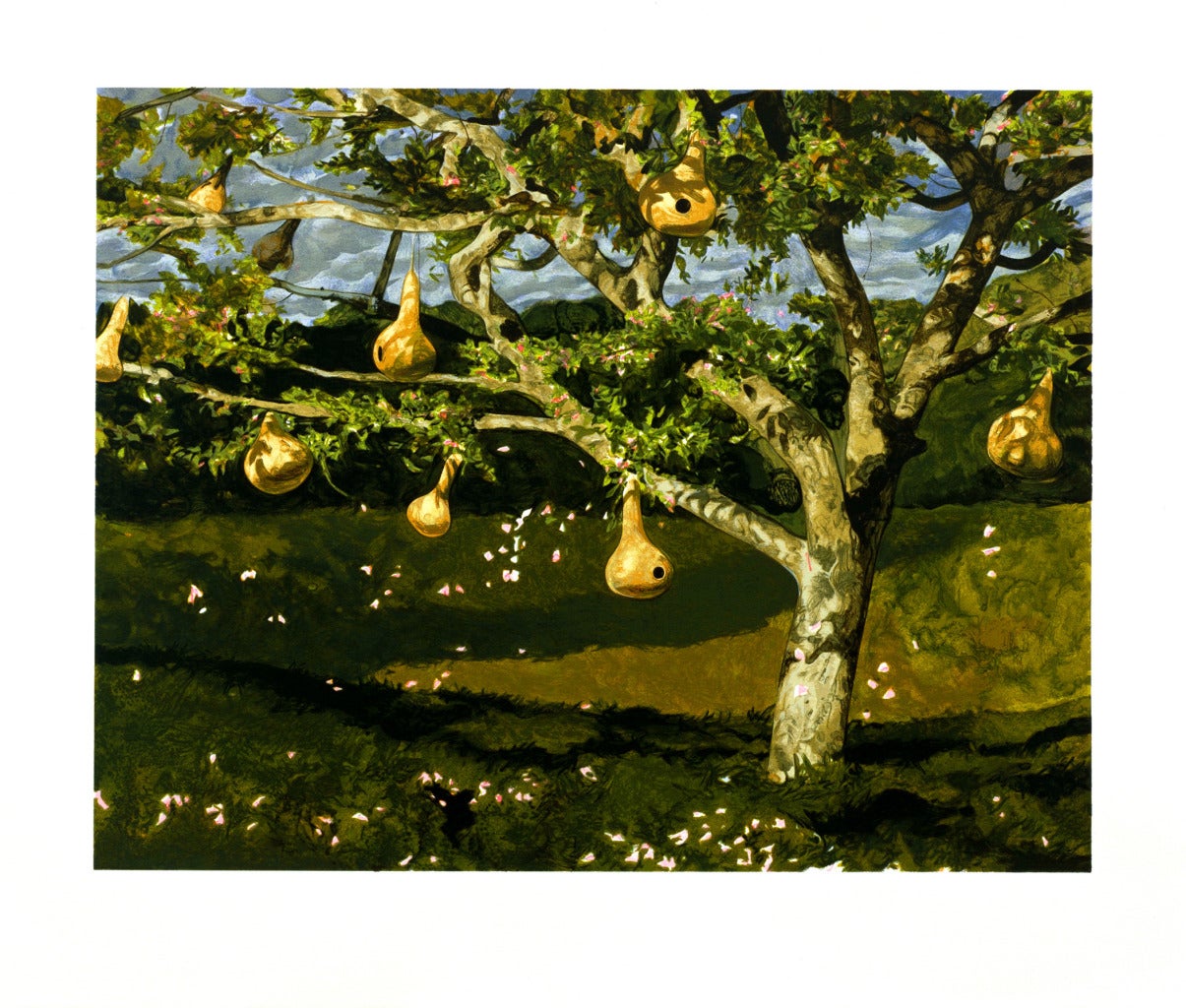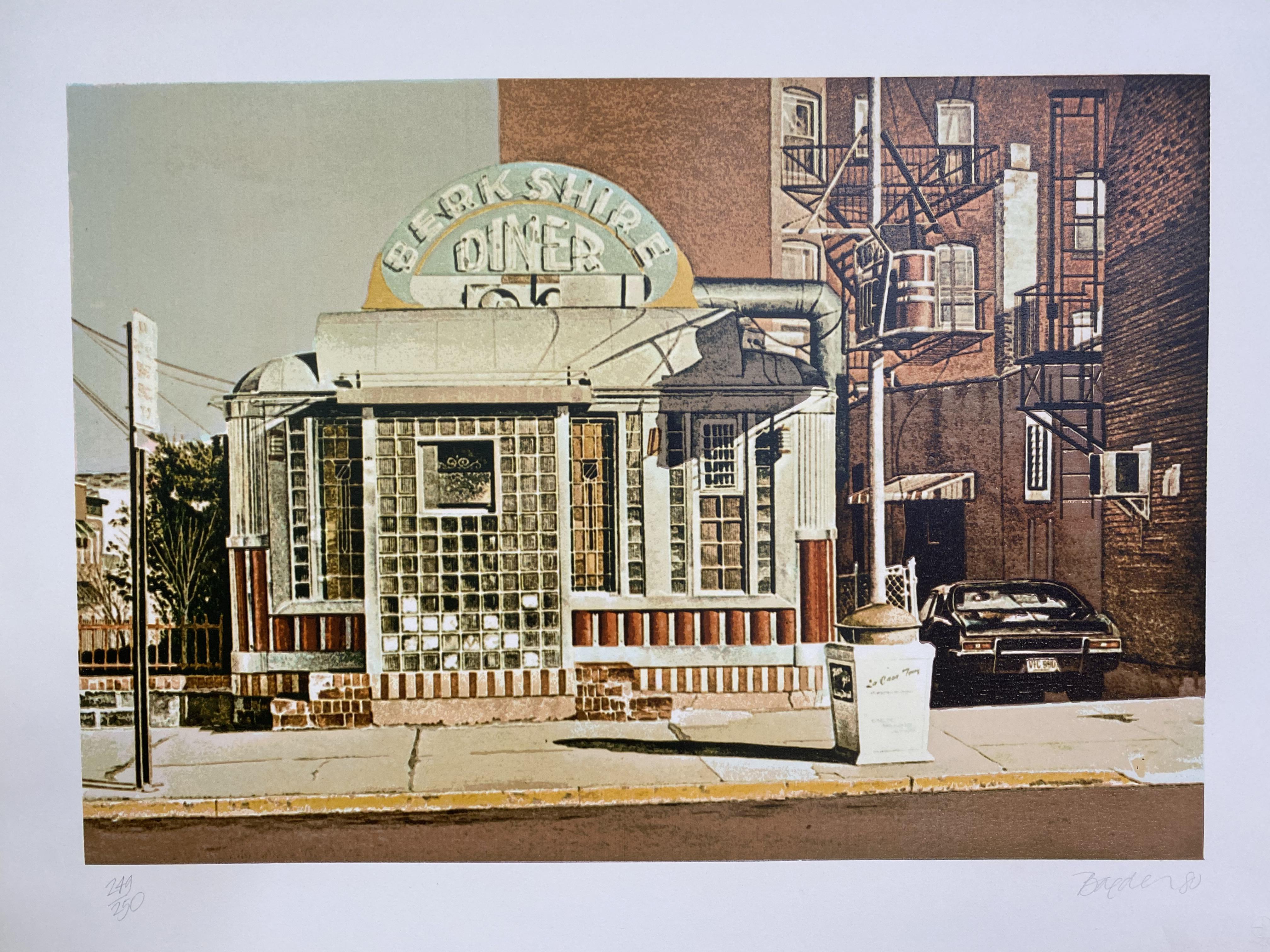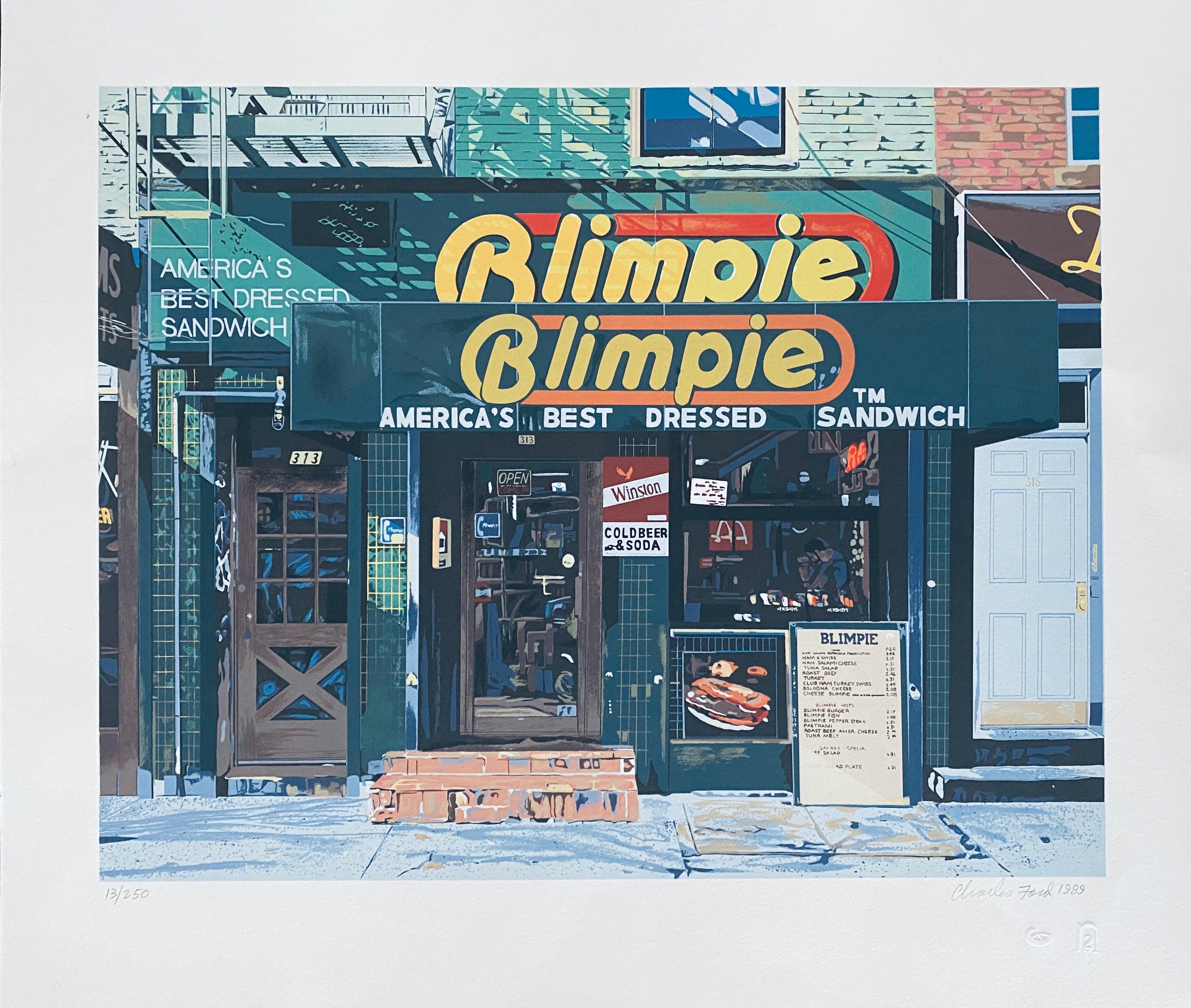Items Similar to Hot, from American Signs Portfolio
Want more images or videos?
Request additional images or videos from the seller
1 of 8
Robert CottinghamHot, from American Signs Portfolio2009
2009
About the Item
ROBERT COTTINGHAM
Hot, from American Signs Portfolio, 2009
screenprint in colors, on wove paper, with full margins
40 1/8 x 39 1/8 in (101.9 x 99.4 cm)
signed, dated `2009' and numbered edition of 100 in pencil
--
Robert Cottingham
B. 1935, BROOKLYN, NEW YORK
Born in 1935 in Brooklyn, Robert Cottingham is known for his paintings and prints of urban American landscapes, particularly building facades, neon signs, movie marquees, and shop fronts. After serving in the U.S. Army from 1955 through 1958, he earned a BFA at Pratt Institute, Brooklyn, in 1963. Cottingham began his professional artistic career as an art director for the advertising firm Young and Rubicam in the early 1960s. Although he is typically associated with Photorealism, Cottingham never considered himself a Photorealist, but rather a realist painter working in a long tradition of American vernacular scenes. In this respect, his work often draws parallels to a number of American painters such as Stuart Davis, Charles Demuth, Edward Hopper, and Charles Sheeler.
Cottingham’s interest in the intersections of art and commerce derive from his career as an adman and the influence of Pop art. Many of his paintings convey an interest in typography and lettering, as well as an awareness of the psychological impact of certain isolated words and letters. In his facades, techniques from advertising, namely cropping and enlarging, often produce words of enigmatic or comical resonance such as “Art,” “Ha,” or “Oh.” Cottingham’s enlarged sense of scale is reminiscent of James Rosenquist’s work, while his interest in text suggests the influence of Robert Indiana and Jasper Johns. In general, Cottingham viewed his work as continuing the legacy of Pop artists such as Andy Warhol, who also had a background in advertising.
In 1964, Cottingham relocated to Los Angeles for work. There, inspired by the drastically different environment of the West Coast metropolis, he began to commit seriously to painting. Fascinated by Hollywood’s exaggerated glitz and the downtrodden atmosphere of the downtown, Cottingham saw in Los Angeles the relics of a bygone commercial heyday and desired to capture its kitschy and uncanny atmosphere, bathed in the near perpetual sunlight of Southern California.
In 1968, Cottingham ended his advertising career in order to devote all his time to painting. In the late 1960s, he started using photography in his practice, first as an initial reference point for his process. After selecting a photograph, he translates it into black-and-white drawings by projecting the image onto gridded paper, as a means of perfecting the tonal range between light and shadow. He often creates subsequent studies on paper using color. He finalizes the process by projecting either the original slide or any of the drawings onto a canvas and organizing the composition according to a grid. Another reason for Cottingham’s rejection of the Photorealist label is that he does not view his works as mere painterly translations of photographs or reproductions of reality. He has been known to change the words in his facades to alter the meaning of the subject. His primary interest lies in the subject matter—the urban American vernacular—rather than the deployment of a photo-based technique. After spending a period of time in London from 1972 to 1976, Cottingham found the city’s signs and history too foreign and removed from his own interests, and returned to the United States to settle in rural Connecticut. During the late 1970s and 1980s, his urban cityscapes became more expansive, with more complex and broader views of storefronts, vistas, and entire neighborhoods. In the late 1980s and early 1990s, Cottingham expanded his iconography of American vernacular culture to include trains and railroad imagery. More recently, he has focused on images of vintage typewriters, a subject that first interested him in the late 1990s.
Cottingham taught at the Art Center College of Design, Los Angeles (1969–70), and the National Academy of Design, New York (1991). He was the artist in residence at Wesleyan University, Middletown, Connecticut (1987–92). His work has been included in significant group exhibitions, including Documenta, Kassel, West Germany (1972), and those at the Serpentine Gallery, London (1973); Centre national d’art contemporain, Paris (1974); Whitney Museum of American Art, New York (1978); a traveling exhibition at the National Museum of American Art (now Smithsonian American Art Museum), Washington, D.C. (1986); Samsung Museum of Modern Art, Seoul (2001); and Deutsche Guggenheim, Berlin (2009). Cottingham’s printed oeuvre was celebrated by a solo presentation at National Museum of American Art in 1998–99. The artist lives and works in western Connecticut.
- Creator:Robert Cottingham (1935, American)
- Creation Year:2009
- Dimensions:Height: 40 in (101.6 cm)Width: 39 in (99.06 cm)
- Medium:
- Movement & Style:
- Period:
- Condition:Full suite of 12 prints from American Signs portfolio available.
- Gallery Location:New York, NY
- Reference Number:1stDibs: LU3261217693
About the Seller
5.0
Vetted Seller
These experienced sellers undergo a comprehensive evaluation by our team of in-house experts.
Established in 1996
1stDibs seller since 2013
655 sales on 1stDibs
Typical response time: 4 hours
- ShippingRetrieving quote...Ships From: New York, NY
- Return PolicyA return for this item may be initiated within 3 days of delivery.
More From This SellerView All
- Blues, from American Signs portfolioBy Robert CottinghamLocated in New York, NYROBERT COTTINGHAM Blues, from American Signs portfolio, 2009 screenprint in colors, on wove paper, with full margins, 40 1/8 x 39 1/8 in (101.9 x 99.4 cm) signed, dated `2009' a...Category
Photorealist Abstract Prints
MaterialsScreen
- Otono FloralBy Julian SchnabelLocated in New York, NYOTONO FLORAL, 1995 Hand-painted, 15-color silkscreen with poured resin 40 x 30 inches (102 x 76 cm) Edition of 80 "Sexual Spring-like Winter" is a large painterly work, created with...Category
1990s Neo-Expressionist Abstract Prints
MaterialsScreen, Resin
- Alex Katz 'Reflection 2'By Alex KatzLocated in New York, NYAlex Katz (born 1927) Reflection 2 2021 Archival pigment ink on Innova Etching Cotton Rag 315 gsm fine art paper 47 x 39.5 inches (119 x 100.3 cm) Edition of 81/100 With flat plane...Category
2010s Modern Abstract Prints
MaterialsScreen
- Donald Sułtan, Mimosa, September 29, 2021By Donald SultanLocated in New York, NYMIMOSA, SEPT 29, 2021 2021 Silkscreen with enamel inks and flocking on Rising 4-ply museum board 42 x 42 inches (107 x 107 cm) Edition of 40 Signed and numbered DONALD SULTAN (b. 1...Category
21st Century and Contemporary Contemporary Abstract Prints
MaterialsScreen
- Kenny Scharf, Sajippe Kraka JoujeshBy Kenny ScharfLocated in New York, NYSAJIPPE KRAKA JOUJESH Year: 1998 Medium: Silkscreen Size: 39 x 46 inches (99 x 117 cm) Edition: 150 Price: $4,000 Kenny Scharf was born in 1958, in Hollywood, California. The artis...Category
1990s Pop Art Landscape Prints
MaterialsScreen
- War is OverBy Shepard FaireyLocated in New York, NYWar is Over Screen Print 18 x 24 inches Edition of 350 Signed and numberedCategory
21st Century and Contemporary Street Art Landscape Prints
MaterialsScreen
You May Also Like
- The Gourd TreeBy Jamie WyethLocated in New York, NYScreenprint, Edition of 108 In 2002, Jamie Wyeth created a richly detailed print for Lincoln Center entitled, The Gourd Tree. Known for his realistic style, Wyeth’s work consists largely of landscapes-- like this unusual tree-- and portraits. Although closely associated with the rural landscape of Chadds Ford Pennsylvania and the rugged coast of Maine, Jamie Wyeth spent part of his early career in New York City, where he was mentored by New York City Ballet founder Lincoln Kirstein...Category
Early 2000s Photorealist Landscape Prints
MaterialsScreen
- Alexandre Ponomarev, Maya, i'ile perdue, Silkscreen, Print, Art, Limited EditionBy Alexander PonomarevLocated in Zug, CHAlexandre Ponomarev Maya-L'île Perdue, 2007 Silkscreen Print Edition of 200 56,5 x 75,6 cm (22.2 x 29.7 in), unframed In mint condition Signed, titled, dated and numbered Accompanied...Category
21st Century and Contemporary Photorealist Landscape Prints
MaterialsScreen
- Alexandre Ponomarev, Maya, i'ile perdue, Silkscreen, Print, Art, Limited EditionBy Alexander PonomarevLocated in Zug, CHAlexandre Ponomarev Maya-L'île Perdue, 2007 Silkscreen Print Edition of 200 56,5 x 75,6 cm (22.2 x 29.7 in), unframed In mint condition Signed, titled, dated and numbered Accompanied...Category
21st Century and Contemporary Photorealist Landscape Prints
MaterialsScreen
- Berkshire Diner - 1980By John BaederLocated in Rochester Hills, MIJohn Baeder Berkshire Diner - 1980 Print - Serigraph on Somerset paper Paper Size - 30'' x 22'' in. Edition: Signed in pencil and marked from the edition of 250 John Baeder's calcula...Category
1980s Photorealist Landscape Prints
MaterialsScreen
- Blimpie, America's Best Dressed Sandwich Pop Art Photo Realist Silkscreen LithoBy Charles FordLocated in Surfside, FLCharles Ford, American Photo Realist Pop Artist Texas Artist Photorealism is a movement which began in the late 1960's, in which scenes are painted in a style closely resembling phot...Category
20th Century Photorealist Landscape Prints
MaterialsScreen
- Downtown Houston, Photorealist Silkscreen by CJ YaoBy Ching Jang YaoLocated in Long Island City, NYArtist: C.J. Yao Title: Downtown Houston Year: 1982 Medium: Silkscreen, signed and numbered in pencil Edition: 250 Paper Size: 22 x 30 inchesCategory
1980s Photorealist Landscape Prints
MaterialsScreen
Recently Viewed
View AllMore Ways To Browse
Cm Hot
Grid Prints
Charles Wells Prints
Vintage Train Signs
Vintage Train Print
Vintage Commercial Signs
Travel Prints 1960s
Vintage American Advertising
Typography Prints
Railroad Print
Original Neon Signs
Vintage Western Prints
Neon Art Vintage
Vintage Neon Art
70s Screen
Vintage Neon Sign
Black And White Pencil Drawings Paris
Black And White Screenprint




